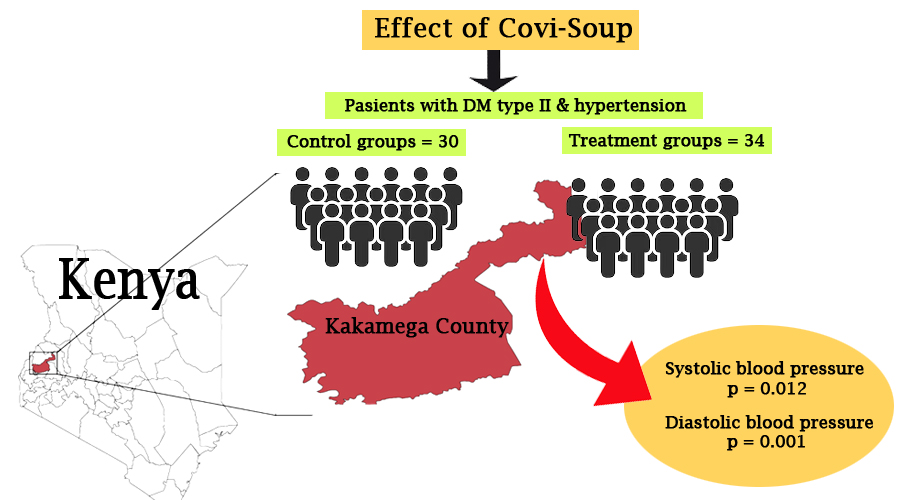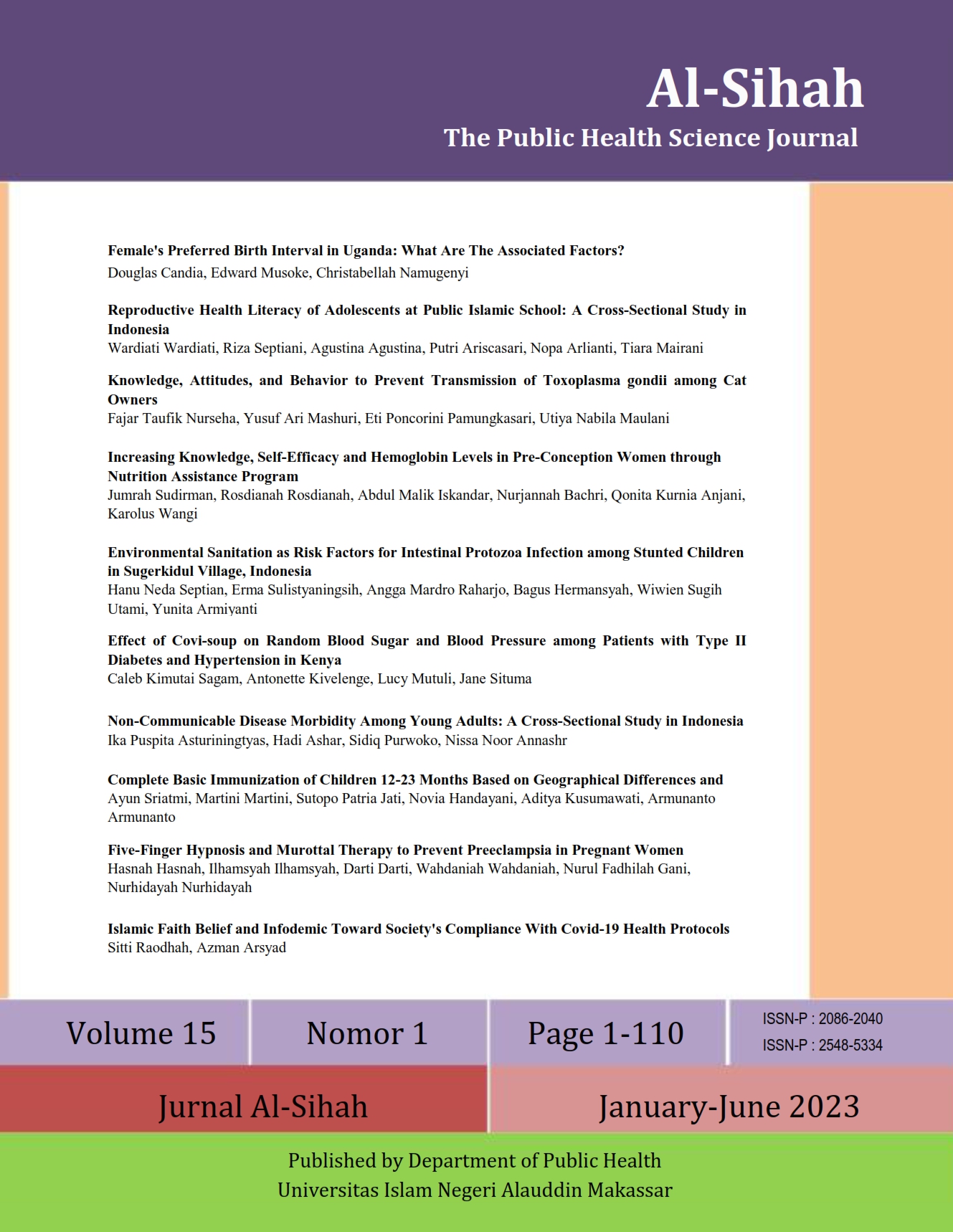Effect of Covi-soup on Random Blood Sugar and Blood Pressure among Patients with Type II Diabetes and Hypertension in Kenya
Abstract
Non-communicable diseases (NCDs) are posing a serious global challenge due to the high impact on health and mortality. These diseases are becoming more prevalent in low and middle-income countries. Therefore, this study aimed to test the effect of Covi-soup on random blood sugar (RBS) and blood pressure among patients with type II diabetes mellitus and hypertension. This was a pilot study conducted in Kakamega County, Kenya. Simple systematic sampling was used in identifying respondents and allocating them to the groups. A total of 64 respondents were involved in this study, with 34 and 30 assigned to the treatment and control groups. The treatment group received Covi-soup, containing butternut squash, ginger, garlic, sunflower pepper, chia seeds, and turmeric, while the control consumed a rice soup. There was no significant difference in baseline RBS and systolic pressure levels in the treatment and control with (P =0.909) and (P =0.218), respectively. There was no positive change in RBS, but a positive change was reported in systolic and diastolic blood pressures (P ≤0.187), (P ≤0.012), and (P ≤0.001) after an intervention. Furthermore, there was a significant difference in RBS, systolic blood pressure, and diastolic blood pressure values of the treatment and non-treatment. The consumption of Covi-soup by patients with type II diabetes mellitus and hypertension for 3 months resulted in reduced blood pressure and random blood sugar levels.

Downloads
References
Ali, B. H., Blunden, G., Tanira, M. O., & Nemmar, A. (2008). Some phytochemical, pharmacological and toxicological properties of ginger (Zingiber officinale Roscoe): A review of recent research. Food and Chemical Toxicology, 46(2), 409-420. https://doi.org/10.1016/j.fct.2007.09.085
Anh, N. H., Kim, S. J., Long, N. P., Min, J. E., Yoon, Y. C., Lee, E. G., Kim, M., Kim, T. J., Yang, Y. Y., Son, E. Y., Yoon, S. J., Diem, N. C., Kim, H. M., & Kwon, S. W. (2020). Ginger on Human Health: A Comprehensive Systematic Review of 109 Randomized Controlled Trials. Nutrients, 12(1). https://doi.org/10.3390/nu12010157
Arreola, R., Quintero-Fabián, S., López-Roa, R. I., Flores-Gutiérrez, E. O., Reyes-Grajeda, J. P., Carrera-Quintanar, L., & Ortuño-Sahagún, D. (2015). Immunomodulation and Anti-Inflammatory Effects of Garlic Compounds. Journal of Immunology Research, 2015, 1-13. https://doi.org/10.1155/2015/401630
Bigna, J. J., & Noubiap, J. J. (2019). The rising burden of non-communicable diseases in sub-Saharan Africa. The Lancet Global Health, 7(10), e1295-e1296.
Clark, C. C. T., Ghaedi, E., Arab, A., Pourmasoumi, M., & Hadi, A. (2019). The effect of curcumin supplementation on circulating adiponectin: A systematic review and meta-analysis of randomized controlled trials. Diabetes Metab Syndr, 13(5), 2819-2825. https://doi.org/10.1016/j.dsx.2019.07.045
Dash, S., Delibasic, V., Alsaeed, S., Ward, M., Jefferson, K., Manca, D. P., & Arcand, J. (2020). Knowledge, attitudes and behaviours related to physician-delivered dietary advice for patients with hypertension. Journal of Community Health, 45, 1067-1072. https://doi.org/10.1007/s10900-020-00831-x
de Paula, T. P., Kramer, C. K., Viana, L. V., & Azevedo, M. J. (2017). Effects of individual micronutrients on blood pressure in patients with type 2 diabetes: a systematic review and meta-analysis of randomized clinical trials. Sci Rep, 7, 40751. https://doi.org/10.1038/srep40751
El Gayar, M. H., Aboromia, M. M., Ibrahim, N. A., & Hafiz, M. H. A. (2019). Effects of ginger powder supplementation on glycemic status and lipid profile in newly diagnosed obese patients with type 2 diabetes mellitus. Obesity Medicine, 14, 100094. https://doi.org/10.1016/j.obmed.2019.100094
Hajimoosayi, F., Jahanian Sadatmahalleh, S., Kazemnejad, A., & Pirjani, R. (2020). Effect of ginger on the blood glucose level of women with gestational diabetes mellitus (GDM) with impaired glucose tolerance test (GTT): a randomized double-blind placebo-controlled trial. BMC Complement Med Ther, 20(1), 116. https://doi.org/10.1186/s12906-020-02908-5
Li, H. (2020). Evaluation of bioactivity of butternut squash ( Cucurbita moschata D.) seeds and skin. Food Science & Nutrition, 8(7), 3252-3261. https://doi.org/10.1002/fsn3.1602
Magkos, F., Hjorth, M. F., & Astrup, A. (2020). Diet and exercise in the prevention and treatment of type 2 diabetes mellitus. Nature Reviews Endocrinology, 16(10), 545-555. https://doi.org/10.1038/s41574-020-0381-5
Mahmoodpoor, A., Medghalchi, M., Nazemiyeh, H., Asgharian, P., Shadvar, K., & Hamishehkar, H. (2018). Effect of Cucurbita Maxima on Control of Blood Glucose in Diabetic Critically Ill Patients. Adv Pharm Bull, 8(2), 347-351. https://doi.org/10.15171/apb.2018.040
Marton, L. T., Pescinini, E. S. L. M., Camargo, M. E. C., Barbalho, S. M., Haber, J., Sinatora, R. V., Detregiachi, C. R. P., Girio, R. J. S., Buchaim, D. V., & Cincotto Dos Santos Bueno, P. (2021). The Effects of Curcumin on Diabetes Mellitus: A Systematic Review. Front Endocrinol (Lausanne), 12, 669448. https://doi.org/10.3389/fendo.2021.669448
Medina-Remón, A., Kirwan, R., Lamuela-Raventos, R. M., & Estruch, R. (2018). Dietary patterns and the risk of obesity, type 2 diabetes mellitus, cardiovascular diseases, asthma, and neurodegenerative diseases. Critical reviews in food science and nutrition, 58(2), 262-296. https://doi.org/10.1080/10408398.2016.1158690
Mohamed, S. F., Mutua, M. K., Wamai, R., Wekesah, F., Haregu, T., Juma, P., Nyanjau, L., Kyobutungi, C., & Ogola, E. (2018). Prevalence, awareness, treatment and control of hypertension and their determinants: results from a national survey in Kenya. BMC Public Health, 18(S3). https://doi.org/10.1186/s12889-018-6052-y
Nandha, R., Singh, H., Garg, K., & Rani, S. (2014). Therapeutic potential of sunflower seeds: An overview. International Journal of Research and Development in Pharmacy & Life Sciences, 3(3), 967-972.
Oktay, A. A., Akturk, H. K., Esenboga, K., Javed, F., Polin, N. M., & Jahangir, E. (2018). Pathophysiology and Prevention of Heart Disease in Diabetes Mellitus. Curr Probl Cardiol, 43(3), 68-110. https://doi.org/10.1016/j.cpcardiol.2017.05.001
Padiya, R., & Banerjee, S. K. (2013). Garlic as an anti-diabetic agent: recent progress and patent reviews. Recent Pat Food Nutr Agric, 5(2), 105-127. https://doi.org/10.2174/18761429113059990002
Prasad, S., & Tyagi, A. K. (2015). Ginger and Its Constituents: Role in Prevention and Treatment of Gastrointestinal Cancer. Gastroenterology Research and Practice, 2015, 1-11. https://doi.org/10.1155/2015/142979
Rasmussen, L., Poulsen, C. W., Kampmann, U., Smedegaard, S. B., Ovesen, P. G., & Fuglsang, J. (2020). Diet and healthy lifestyle in the management of gestational diabetes mellitus. Nutrients, 12(10), 3050. https://doi.org/10.3390/nu12103050
Ried, K., Frank, O. R., Stocks, N. P., Fakler, P., & Sullivan, T. (2008). Effect of garlic on blood pressure: A systematic review and meta-analysis. BMC Cardiovascular Disorders, 8(1). https://doi.org/10.1186/1471-2261-8-13
Rostamkhani, H., Faghfouri, A. H., Veisi, P., Rahmani, A., Noshadi, N., & Ghoreishi, Z. (2022). The protective antioxidant activity of ginger extracts (Zingiber Officinale) in acute kidney injury: A systematic review and meta-analysis of animal studies. Journal of Functional Foods, 94, 105111. https://doi.org/10.1016/j.jff.2022.105111
Sagam, C., Kivelenge, A., Olayo, R., Wanjala, C., Mutai, C., Wesonga, B., Mutuli, L., & Situma, J. (2023). Effect of Covi-soup on CD4 cell count and haemoglobin among patients with diabetes type II and hypertension in Kakamega county, Kenya: A randomized control trial. African Journal of Food, Agriculture, Nutrition and Development, 23(2), 22568-22584. https://doi.org/10.18697/ajfand.117.22910
Sethi, N., Kaura, S., Dilbaghi, N., Parle, M., & Pal, M. (2014). Garlic: A Pungent Wonder from Nature. International Research Journal of Pharmacy, 5(7), 523-529. https://doi.org/10.7897/2230-8407.0507106
Shango, A. J., Majubwa, R. O., & Maerere, A. P. (2021). Morphological characterization and yield of pepper (Piper nigrum L.) types grown in Morogoro District, Tanzania. CABI Agriculture and Bioscience, 2(1). https://doi.org/10.1186/s43170-021-00028-9
Srinivasan, K. (2014). Antioxidant potential of spices and their active constituents. Crit Rev Food Sci Nutr, 54(3), 352-372. https://doi.org/10.1080/10408398.2011.585525
Toscano, L. T., Toscano, L. T., Leite Tavares, R., da Oliveira Silva, C. S., & Silva, A. S. (2014). Chia induces clinically discrete weight loss and improves lipid profile only in altered previous values. Nutr Hosp, 31(3), 1176-1182. https://doi.org/10.3305/nh.2015.31.3.8242
Ullah, R., Nadeem, M., Khalique, A., Imran, M., Mehmood, S., Javid, A., & Hussain, J. (2016). Nutritional and therapeutic perspectives of Chia (Salvia hispanica L.): a review. J Food Sci Technol, 53(4), 1750-1758. https://doi.org/10.1007/s13197-015-1967-0
Wang, J., Zhang, X., Lan, H., & Wang, W. (2017). Effect of garlic supplement in the management of type 2 diabetes mellitus (T2DM): a meta-analysis of randomized controlled trials. Food Nutr Res, 61(1), 1377571. https://doi.org/10.1080/16546628.2017.1377571
World Health Organization. (2018). Noncommunicable diseases country profiles 2018. https://apps.who.int/iris/handle/10665/274512
Yoshizaki, T., Milne, J. C., Imamura, T., Schenk, S., Sonoda, N., Babendure, J. L., Lu, J. C., Smith, J. J., Jirousek, M. R., & Olefsky, J. M. (2009). SIRT1 exerts anti-inflammatory effects and improves insulin sensitivity in adipocytes. Mol Cell Biol, 29(5), 1363-1374. https://doi.org/10.1128/MCB.00705-08
Zhu, J., Chen, H., Song, Z., Wang, X., & Sun, Z. (2018). Effects of Ginger (Zingiber officinale Roscoe) on Type 2 Diabetes Mellitus and Components of the Metabolic Syndrome: A Systematic Review and Meta-Analysis of Randomized Controlled Trials. Evid Based Complement Alternat Med, 2018, 5692962. https://doi.org/10.1155/2018/5692962
Copyright (c) 2023 Caleb Kimutai Sagam, Antonette Kivelenge, Lucy Mutuli, Jane Situma

This work is licensed under a Creative Commons Attribution-NonCommercial-ShareAlike 4.0 International License.
Authors retain copyright and grant the journal right of first publication with the work simultaneously licensed under a Creative Commons Attribution-NonCommercial-ShareAlike 4.0 International License that allows others to share the work with an acknowledgment of the work's authorship and initial publication in this journal.
Authors are able to enter into separate, additional contractual arrangements for the non-exclusive distribution of the journal's published version of the work (e.g., post it to an institutional repository or publish it in a book), with an acknowledgment of its initial publication in this journal.
Authors are permitted to publish their work online in third parties as it can lead to wider dissemination of the work.






